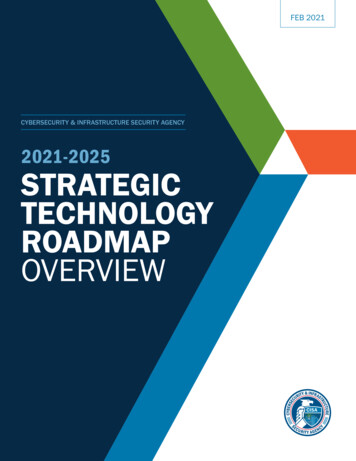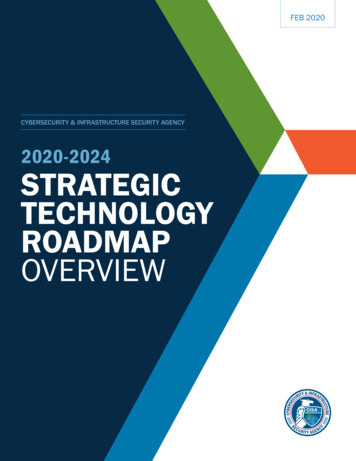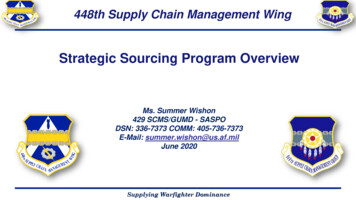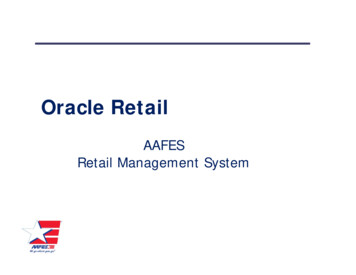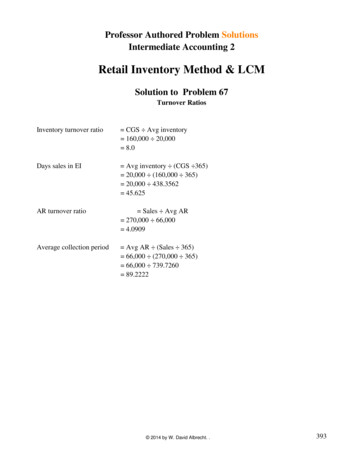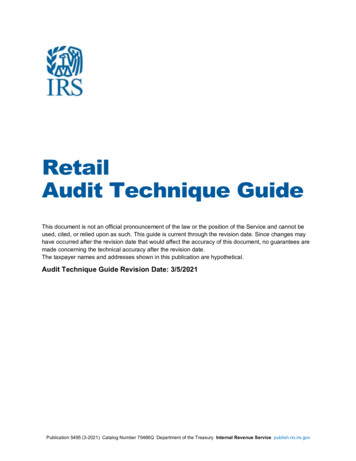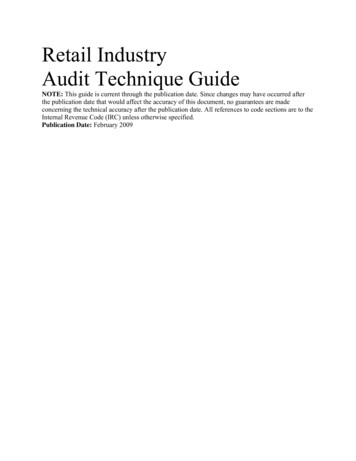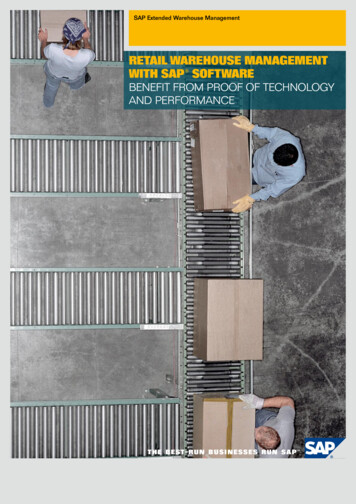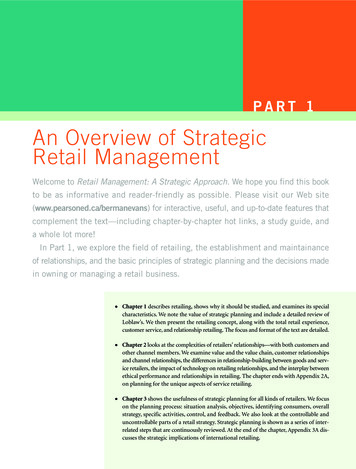
Transcription
PART 1An Overview of StrategicRetail ManagementWelcome to Retail Management: A Strategic Approach. We hope you find this bookto be as informative and reader-friendly as possible. Please visit our Web site(www.pearsoned.ca/bermanevans) for interactive, useful, and up-to-date features thatcomplement the text—including chapter-by-chapter hot links, a study guide, anda whole lot more!In Part 1, we explore the field of retailing, the establishment and maintainanceof relationships, and the basic principles of strategic planning and the decisions madein owning or managing a retail business. Chapter 1 describes retailing, shows why it should be studied, and examines its specialcharacteristics. We note the value of strategic planning and include a detailed review ofLoblaw’s. We then present the retailing concept, along with the total retail experience,customer service, and relationship retailing. The focus and format of the text are detailed. Chapter 2 looks at the complexities of retailers’ relationships—with both customers andother channel members. We examine value and the value chain, customer relationshipsand channel relationships, the differences in relationship-building between goods and service retailers, the impact of technology on retailing relationships, and the interplay betweenethical performance and relationships in retailing. The chapter ends with Appendix 2A,on planning for the unique aspects of service retailing. Chapter 3 shows the usefulness of strategic planning for all kinds of retailers. We focuson the planning process: situation analysis, objectives, identifying consumers, overallstrategy, specific activities, control, and feedback. We also look at the controllable anduncontrollable parts of a retail strategy. Strategic planning is shown as a series of interrelated steps that are continuously reviewed. At the end of the chapter, Appendix 3A discusses the strategic implications of international retailing.
Chapter 1An Introduction to RetailingA perfect example of a dream come true is the story of SamWalton, the founder of Wal-Mart (www.walmart.com). From asingle store, Wal-Mart has grown to become the world’s largestretailer (in terms of revenues).As a store owner in Bentonville, Arkansas, Sam Walton hada simple strategy: to take his retail stores to rural areas of theUnited States and then sell goods at the lowest prices around.Sam was convinced that a large discount format would workin rural communities.Walton’s first discount store opened in 1962 and used suchslogans as “We sell for less” and “Satisfaction guaranteed,”two of the current hallmarks of the company. By the end of1969, Wal-Mart had expanded to 31 locations. Within a year,Wal-Mart became a public corporation and rapidly grew onReprinted by permission.the basis of additional discount stores, its supercentre format,and global expansion to more than 1,300 stores and clubs in nine countries, employingmore than 300,000 associates. Canada has played a key role in this expansion, with the founding of Wal-Mart Canada in March of 1994. Today, Wal-Mart Canada has more than 230 storesand five Sam’s Clubs, employing more than 60,000 Canadians from coast to coast.Wal-Mart has become a true textbook example of how a retailer can maintain growth without losing sight of its original core values of low overhead, the use of innovative distributionsystems, and customer orientation—whereby employees swear to serve the customer. “So helpme, Sam.”1The road hasn’t been entirely smooth, though. Opposition to Wal-Mart’s business practiceshas been growing, and the company has been criticized for its employment practices relatedto illegal immigrants. Residents of many communities have attempted to block Wal-Martfrom opening new stores, and Wal-Mart has closed a store in Quebec that was threateningto unionize. Competing on price, and therefore on costs, has its own price. Time will tell howmuch consumers are willing to pay for everyday low prices.Chapter Objectives1. To define retailing, consider it from various perspectives, demonstrate its impact, and note its specialcharacteristics2. To introduce the concept of strategic planning and apply it
Chapter 1 An Introduction to Retailing33. To show why the retailing concept is the foundation of a successful business, with anemphasis on the total retail experience, customer service, and relationship retailing4. To indicate the focus and format of the textOverviewRetailing encompasses the business activities involved in selling goods and services to consumers for their personal, family, or household use. While retailing can be defined as including every sale to the final consumer (ranging from cars to apparel to meals at restaurants),we normally focus on those businesses that sell “merchandise generally without transformation, while rendering services incidental to the sale of merchandise.”2Retailing today is at an interesting crossroads. On the one hand, retail sales are at their highest point in history. Wal-Mart is now the leading company in the world in terms of sales—ahead of ExxonMobil, General Motors, and other manufacturing giants. New technologies areimproving retail productivity. There are lots of opportunities to start a new retail business—orwork for an existing one—and to become a franchisee. Global retailing possibilities abound.On the other hand, retailers face numerous challenges. Many consumers are bored with shopping or do not have much time for it. Some locales have too many stores, and retailersoften spur one another into frequent price cutting (and low profit margins). Customer serviceexpectations are high at a time when more retailers offer self-service and automated systems.At the same time, many retailers remain unsure about what to do with the Web; they are stillgrappling with the emphasis to place on image enhancement, customer information and feedback, and sales transactions.These are the issues that retailers must resolve: “How can we best serve our customers whileearning a fair profit?” “How can we stand out in a highly competitive environment where consumers have so many choices?” “How can we grow our business while retaining a core ofVisit Krispy Kreme(www.krispykreme.com) andsee what drives what was one ofthe world’s “hot” retailers.loyal customers?” Our point of view: Retail decisionmakers can best address these questions by fully understanding and applying the basic principles of retailing ina well-structured, systematic, and focused retail strategy.That is the philosophy behind Retail Management: AStrategic Approach.Can retailers flourish in today’s tough marketplace?You bet! Just look at your favourite restaurant, gift shop,and food store. Look at the growth of Shoppers DrugMart/Pharma Prix, Loblaws, or such iconic examples asCanadian Tire or Tim Hortons. Is it easy? No. Look at theexperience in early 2005 of Krispy Kreme, which was atthat time closing stores in Ontario and facing lawsuitsfrom its shareholders over allegations of overstatingrevenues.To prosper in the long term, all retailers need a strategic plan and a willingness to adapt, both of which areFIGURE 1-1central thrusts of this book. See Figure 1-1.By consistently fulfilling its simple mission statement—“to continually provide ourmembers with quality goods and services at the lowest possible prices”—Costco hasgrown into a retailing dynamo. It now operates hundreds of membership stores inCanada, the United States, Great Britain, Taiwan, Korea, Japan, and Mexico.In Chapter 1, we will look at the framework of retailing,the importance of developing and applying a sound retail strategy, and the focus and format of the text.Boom Times for CostcoPhoto reprinted by permission of Retail Forward, Inc.
4Part One An Overview of Strategic Retail ManagementTHE FRAMEWORK OF RETAILINGTo better appreciate the role of retailing and the range of retailing activities, let us view it fromthree different perspectives: Suppose we manage a manufacturing firm that makes vacuum cleaners. How should wesell these items? We could distribute via big chains (such as Future Shop) or small neighbourhood appliance stores, have our own salesforce visit people in their homes (as Aerus—formerly Electrolux—does), or set up our own stores (if we have the ability and resourcesto do so). We could sponsor TV infomercials or magazine ads, complete with a toll-freephone number. Suppose we have an idea for a new way to teach first graders how touse computer software for spelling and vocabulary. How should weimplement this idea? We could lease a store in a strip shopping centre and run ads in a local paper, rent space in a Y and rely on teacherreferrals, or do mailings to parents and visit children in their homes.In each case, the service is offered “live.” But there is another option:We could use an animated Web site to teach children online. Fig 1-2 new to comeSuppose that we, as consumers, want to buy apparel. What choices dowe have? We could go to a department store or an apparel store. Wecould shop with a full-service retailer or a discounter. We could go toa shopping centre or order from a catalogue. We could look to retailers that carry a wide range of clothing (from outerwear to jeans tosuits) or look to firms that specialize in one clothing category (suchas leather coats). We could zip around the Web and visit retailersaround the globe.Retailing does not have to involve a store. Mail and phone orders,direct selling to consumers in their homes and offices, Web transactions,and vending machine sales all fall within the scope of retailing. Retailingdoes not even have to include a “retailer.” Manufacturers, importers,nonprofit firms, and wholesalers act as retailers when they sell to finalconsumers.Let us now examine various reasons for studying retailing and itsspecial characteristics.Reasons for Studying RetailingFIGURE 1-22 lines Figure titleto comeFigureCaptionto come.Source: Retail Council of CanadaRetailing is an important field to study because of its impact on theeconomy, its functions in distribution, and its relationship with firms selling goods and services to retailers for their resale or use. These factors arediscussed next. A fourth factor for students of retailing is the broadrange of career opportunities, as highlighted with a “Careers in Retailing”box in each chapter and a section on our Web site (www.pearsoned.ca/bermanevans). See Figure 1-2.According to Statistics Canada, 2003 annual Canadian retail storesales (excluding motor vehicles and parts) were almost 250 billion,making Canada the tenth-largest retail market in the world.3 This is despite Canada’s having only the 34th-largest population. Retail Forward,a global management consulting and market research firm specializingin retailing and consumer products marketing, describes the opportunity in Canada as being among the best in the world. Canada’s marketis characterized by real growth and low risk (see Figure 1-3).On a global basis, the world’s ten largest retailers generated sales ofU.S. 741.9 billion in 2003. Of these ten companies, six are based in theUnited States, a finding that would not surprise Canadians, who arevery familiar with U.S. firms. See Figure 1-4.
Chapter 1 An Introduction to Retailing5CAREERS IN RETAILINGMany Career Opportunities Are Available in RetailingAlthough the typical entry-level positions in retailing for a postsecondary graduate include retail management trainee,department/sales manager, and assistant buyer, it is generally difficult to classify retail career opportunities—becausethere are so many of them. Most large retail organizations can be described as “small cities.” As such, these retailersoffer career paths in almost every aspect of business, such as buying, store operations, accounting, financial management, human resources, advertising, public relations, marketing research, and so on.The ideal candidate pursuing a retail career should possess the following qualities: Be a “people person” to understand customer needs and be an effective team member. Be flexible to be able to perform a variety of tasks throughout the workday. Be decisive to make quick decisions that are well thought out. Have analytical skills to analyze data and predict trends. Have stamina to be able to work under pressure for long time periods.What makes retailing so fascinating is the constant change that a retail executive must understand and manage.Among the areas of retailing that are now undergoing rapid change are the increased importance on nonstore retailing,the focus on customer satisfaction, and the application of technology to all areas of retailing. These changes representboth opportunities and challenges.Source: “Careers in Retailing,” www.nrf.com, January 27, 2003.Nationally, the top ten retailers in Canada in 2003 are listed in Figure 1-5. Wal-Mart, in justten years, has become Canada’s third-largest retailer. As discussed in subsequent chapters,Wal-Mart has yet to introduce its supercentres to Canada (these include a full grocery storeLow RiskBest Opportunity QuadrantChileGermanyCanadaUnited ceMalaysiaThailandIndiaBrazilWestern EuropeCentral & Eastern EuropeNorth AmericaLatin AmericaAsia-PacificArgentinaHigh RiskLow GrowthFIGURE 1-3RussiaChinaVietnamHigh GrowthGlobal Retail Opportunity MapExplanatory Note: The relative size of each country’s retail market is represented by the size of its bubble. The mapping horizontally represents the country’s forecasted growth along a continuum of low-to-high growth. The mappingvertically represents the country’s risk level along a continuum of low-to-high risk. Where each axis line crosses thecontinuum represents average growth or risk. So countries mapped on the right half represent higher than averagegrowth. And countries mapped on the top half represent lower than average risk. The best opportunities are in thetop right quadrant, which represents low risk/high growth opportunities.Source: Retail Forward Inc.Learn more about the excitingarray of retailing career opportunities (www.retailcouncil.ca).Curious about recent trends inretail? Visit www.trendwatching.com and www.springwise.comto learn about the latest developments.
6Part One An Overview of Strategic Retail Management2002 2003Rank Rank CompanyHome ContryNet SalesShare of Share of(Million USD) Top 100 Top 20011Wal-Mat Stores Inc.United States 256,32911.9%10.1%22Carrefour GroupFrance 79,7613.7%3.1%33The Home Deopt Inc.United States 64,8163.0%2.5%54Metro AGGermany 60,6482.8%2.4%45The Kroger Co.United States 53,7912.5%2.1%86Tesco PLC.United Kingdom 50,3702.3%2.0%77Target Corp.United States 46,7812.2%1.8%68RoyalAjp;dNetherlands 44,2832.1%1.7%109TIM Entreprise SAFrance 43,4532.0%1.7%910Costco Companies Inc.United States 41,6931.9%1.6%FIGURE 1-4Economic Concentration of the Leading Companies, 2003Source: Company annual reports, published reports, and Retail Forward Inc.Ranked by Total Sales in CanadaCanada Sales and StoresHeadquartersPrimary Retail Net Sales % Chg TotalPrimary( US Mil) Sales StoresCanadaFDM13,4412 Empire Company LimitedCanadaFDM3 Wal-Mart1United StatesFDM4 Hudson’s Bay CompanyCanadaApparel,Home, FDMCompany1 Loblaw Companies 2%5625 CostcoUnited StatesFDM5,23710.2%636 Canadian Tire Corp. Ltd.CanadaHome4,3439.3%9967 Shoppers Drug Mart Corp.CanadaFDM4,33811.4%9188 Sears CanadaUnited StatesApparel4,168–5.8%4299 Safeway10 Home Depot1United StatesFDM4,04316.3%216United StatesHome3,24316.1%102Total Top 10 SalesShare of Non-Auto SalesFIGURE 1-51Sales 59,42634%Top Ten Retailers in Canada, 2003in Canada estimated by Retail Forward.Source: Company annual reports, published reports, and Retail Forward Inc.assortment added to Wal-Mart’s traditional lines). When Wal-Mart does add those supercentres, both Loblaws (currently number one) and Empire—owner of Sobeys—will be hardpressed to hold their current sales levels.Turning now to domestic retailers in Canada, we see in Figure 1-6 many familiar companiesled again by Loblaws—one of Canada’s most innovative and successful firms.From a cost perspective, retailing is a significant field of study. There is a saying that “Thesecret of retail is in the detail.” Imagine owning a company where 87 cents of every dollar insales goes to pay suppliers and personnel, and to cover the rent, heat, lights, and other costs.After paying interest to the bank, taxes to the government, and various other expenses, youhave less than six cents left over. Talk about thin margins. But that’s what (very successful)Shoppers Drug Mart experienced in 2003.4 And Shoppers was lucky. Hbc (owner of The
Chapter 1 An Introduction to RetailingRanked by Total Global SalesTotal Sales and StoresGlobal Rank and PenetrationDomestic Market2003 Rank,Top 200PrimaryNet Sales % Chg Total RetailersRetail Sector ( US Mil) Sales Stores WorldwideSingleShareCountry, NumberofRegionalofTotalor Global Countries SalesShareofTotalStores1 Loblaw Companies LimitedFDM13,4419.7%1,64146Single Country 1100%100%2 Empire Company LimitedFDM7,9136.1%1.31188Single Country 1100%100%3 Hudson’s Bay CompanyApparel,Home, FDM5,3010.2%562117Single Country 1100%100%4 Canadian Tire Corp. Ltd.Home4,3439.3%996139Single Country 1100%100%Company5 Shoppers Drug Mart Corp.FDM4,33811.4%916140Single Country 1100%100%6 Alimentation Couche-TardAlimentration 937%22%7 Jean Coutus Group Inc.Jean Coutu Group Inc., 9%8 Home Hardware Stores Ltd.Home2,72222.7%1,000200Single Country 1100%100%9 RONA Inc.Home2,24534.4%528Single Country 1100%100%10 Metro Inc.FDM1,9948.2%800Single Country 1100%100%11 London Drugs Ltd.FDM1,2397.5%59Single Country 1100%100%12 Sodisco-Howden Group Inc.Home1,2180.7%800Single Country 1100%100%13 Forzani Group Ltd., TheHome7935.1%383Single Country 1100%100%14 7-Eleven Canada Inc.FDM635 –21.4%491Single Country 1100%100%15 Brick Group, TheApparel63481Single Country 1100%100%16 Pharmassve Drugs Ltd.Home6167.6%330Single Country 1100%100%17 ReitmansApparel61013.2%845Single Country 1100%100%18 Indigo Books & Music Inc.Home5773.4%255–Single Country 1100%100%19 North West CompanyNorth West Company, CanadaFDM5614414.4%8.8%181156–Regional275%86%20 Leon’s Furniture Ltd.Home3278.2%55Single Country 1100%100%21 La Senza Corp.La Senza Corp., re 1-64.2%Leading Domestic Retailers in Canada, 2003Sources: Company annual reports, published reports, and Retail Forward Inc.Bay, Zellers, and Home Outfitters) took home only one-half of one cent in after-tax profitsin 2003 ( 69 million on sales of 7.4 billion).5Retail Functions in Distribution Retailing is the last stage in a channel of distribution—all of the businesses and people involved in the physical movement and transfer of ownership of goods and services from producer to consumer. Retailers often act as the contactbetween manufacturers, wholesalers, and the consumer. Many manufacturers would like tomake one basic type of item and sell their entire inventory to as few buyers as possible, butconsumers usually want to choose from a variety of goods and services and purchase a limited quantity. Retailers collect an assortment from various sources, buy in large quantity,and sell in small amounts. This is the sorting process.Another job for retailers is communicating both with customers and with manufacturersand wholesalers. Shoppers learn about the availability and characteristics of goods and services, store hours, sales, and so on, from retailer ads, salespeople, and displays. Manufacturersand wholesalers are informed by their retailers about sales forecasts, delivery delays, customer187
8Part One An Overview of Strategic Retail ManagementRoots (www.roots.com) is notonly a designer but is also aretailer.complaints, defective items, inventory turnover, and more. Many goods a
as leather coats). We could zip around the Web and visit retailers around the globe. Retailing does not have to involve a store. Mail and phone orders, direct selling to consumers in their homes and offices,Web transactions, and vending machine sales all fall within the scope of retaili


